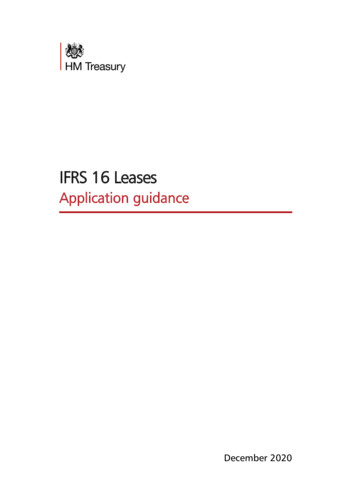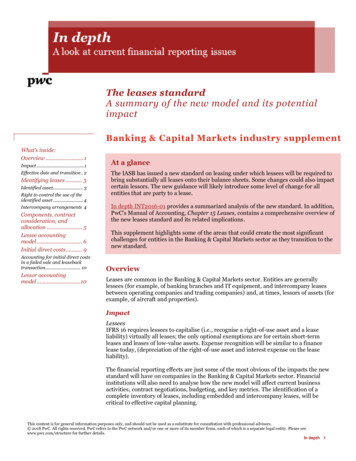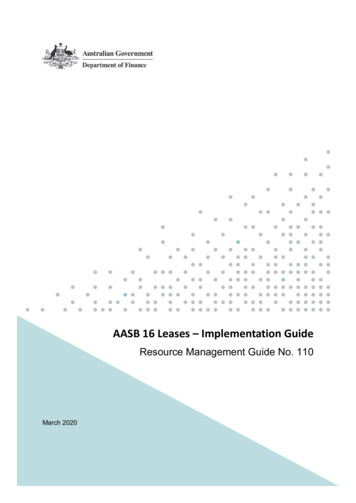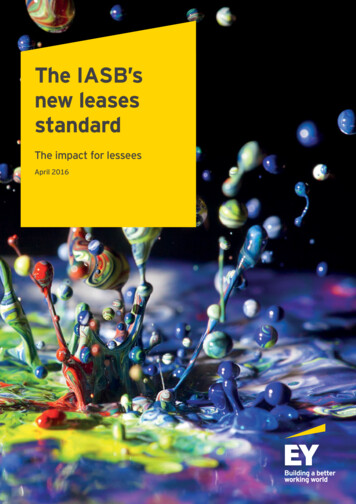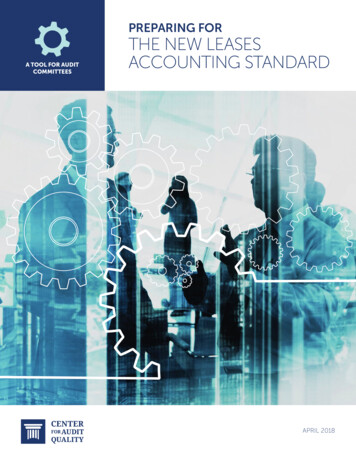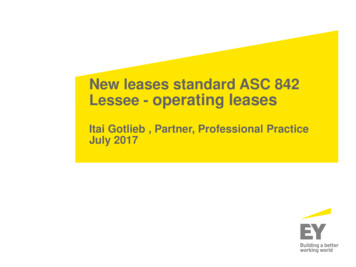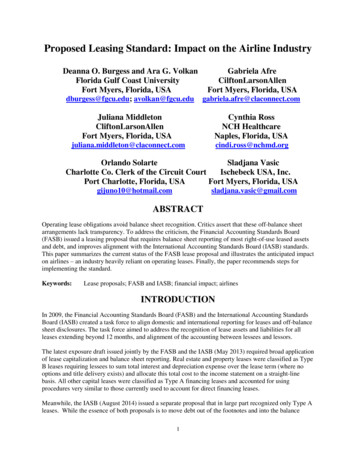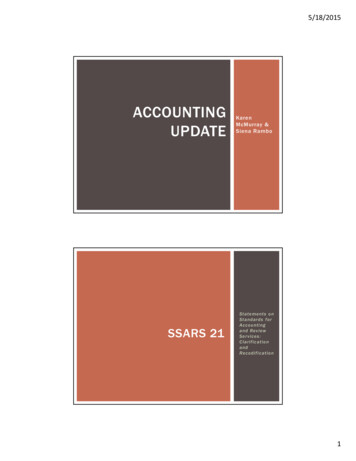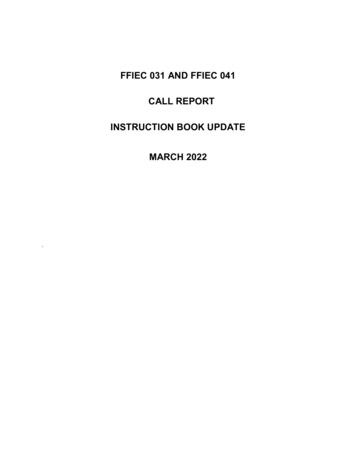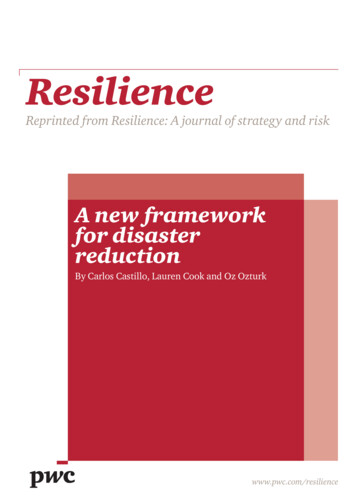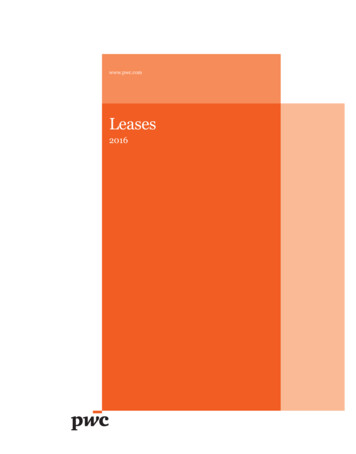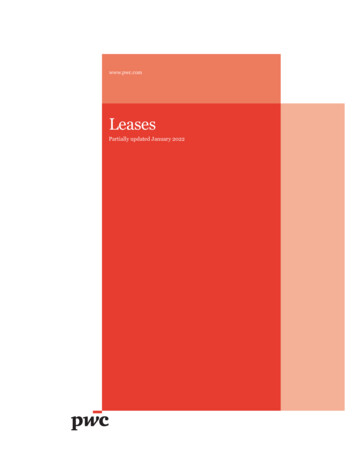
Transcription
www.pwc.comLeasesPartially updated January 2022
About the Leases guidePwC is pleased to offer our updated Leases guide. The FASB’s new standard on leases, ASC 842, isalready effective for public companies and is replacing today’s leases guidance for other companies in2021. This guide discusses lessee and lessor accounting under ASC 842. The first four chapters providean introduction and guidance on determining whether an arrangement is (or contains) a lease andhow to classify and account for lease and nonlease components. This guide also discusses themodification, remeasurement, and termination of a lease, sale and leaseback transactions, leveragedlease transactions, as well as other topics. Chapters 9 and 10 address the presentation and disclosurerequirements as well as the effective date and transition.This guide summarizes the applicable accounting literature, including relevant references to andexcerpts from the FASB’s Accounting Standards Codification (the Codification). It also provides ourinsights and perspectives, interpretative and application guidance, illustrative examples, anddiscussion on emerging practice issues.This guide should be used in combination with a thorough analysis of the relevant facts andcircumstances, review of the authoritative accounting literature, and appropriate professional andtechnical advice.References to US GAAPDefinitions, full paragraphs, and excerpts from the FASB’s Accounting Standards Codification areclearly labelled. In some instances, guidance was cited with minor editorial modification to flow in thecontext of the PwC Guide. The remaining text is PwC’s original content.References to other PwC guidanceThis guide provides general and specific references to chapters in other PwC guides to assist users infinding other relevant information. References to other guides are indicated by the applicable guideabbreviation followed by the specific section number. The other PwC guides referred to in this guide,including their abbreviations, are: Business combinations and noncontrolling interests (BCG) Bankruptcies and liquidations (BLG) Consolidation (CG) Financial statement presentation (FSP) Financing transactions (FG) Income taxes (TX) Loans and investments (LI) Revenue from contracts with customers (RR)
About this guide Transfers and servicing of financial assets (TS)Summary of significant changesFollowing is a summary of the noteworthy revisions. Additional updates may be made to keep pacewith significant developments.Revisions made in January 2022LG 3, Classification LG 3.3.4.6 was updated to clarify that public business entities may not use a risk-free rate astheir incremental borrowing rate, and to describe ASU 2021-09: Discount Rate for Lessees ThatAre Not Public Business Entities.LG 9, Presentation and disclosure LG 9.2.4 was updated to include the disclosure requirements under ASU 2021-09. LG 9.7.2 was added to reflect the transition disclosure requirements for those nonpublicbusiness entities that already adopted ASC 842 on or before the issuance of ASU 2021-09.LG 10, Effective date and transition LG 10.11 was added to discuss the effective dates and transition requirements of ASU 2021-09.Revisions made in September 2021LG 1, Introduction Figure LG 1-2 in LG 1.3 was updated to reflect the impact of ASU 2021-05 upon adoption onlessor accounting.LG 2, Scope Example LG 2-14, Example LG 2-15 and Example LG 2-16 in LG 2.4.6.1 were updated toillustrate the impact of adopting ASU 2021-05 on the allocation of variable consideration betweenlease and nonlease components.LG 3, Classification Figure LG 3-2 in LG 3.2, LG 3.3 and Question LG 3-2 in LG 3.3 were updated to reflect theimpact of ASU 2021-05 upon adoption. LG 3.3.4.6 was updated to clarify that public business entities may not use a risk-free rate astheir incremental borrowing rate, and to describe a proposed ASU: Discount Rate for Lessees ThatAre Not Public Business Entities.
About this guideLG 4, Accounting for leases LG 4.3.1.1, Example LG 4-9 in LG 4.3.1.4, LG 4.3.2.1, and LG 4.3.3 were updated to reflectthe impact of ASU 2021-05 upon adoption on the initial recognition and measurement for lessors. LG 4.5 and LG 4.5.1 were updated to reflect the impact of ASU 2021-05 upon adoption onsubsequent recognition and measurement for lessors.LG 5, Modification and remeasurement of a lease Figure LG 5-4 and Figure LG 5-5 in LG 5.3.6 were updated to reflect the impact of ASU 2021-05upon adoption on the remeasurement of a lease for a lease modification or other event. Question LG 5-7 in LG 5.8 was added to discuss the income statement recognition by a lessor fora payment made to a lessee to induce the lessee to terminate an operating lease before the end ofthe lease term when the payment meets the definition of initial direct cost.LG 6, Sale and leaseback transactions Former Question LG 6-2 was replaced with a new Question LG 6-2 in LG 6.3.4 to describe theaccounting when the leaseback of a building is a finance lease and the leaseback of the underlyingland is an operating lease in a sale and leaseback transaction involving land and building.LG 9, Presentation and disclosure LG 9.3.2.1 was updated to reflect the impact of ASU 2021-05 upon adoption on lessor incomestatement presentation.LG 10, Effective date and transition LG 10.10 was added to discuss the effective dates and transition requirements of ASU 2021-05.CopyrightsThis publication has been prepared for general informational purposes, and does not constituteprofessional advice on facts and circumstances specific to any person or entity. You should not actupon the information contained in this publication without obtaining specific professional advice. Norepresentation or warranty (express or implied) is given as to the accuracy or completeness of theinformation contained in this publication. The information contained in this publication was notintended or written to be used, and cannot be used, for purposes of avoiding penalties or sanctionsimposed by any government or other regulatory body. PricewaterhouseCoopers LLP, its members,employees, and agents shall not be responsible for any loss sustained by any person or entity thatrelies on the information contained in this publication. Certain aspects of this publication may besuperseded as new guidance or interpretations emerge. Financial statement preparers and other usersof this publication are therefore cautioned to stay abreast of and carefully evaluate subsequentauthoritative and interpretative guidance.The FASB material is copyrighted by the Financial Accounting Foundation, 401 Merritt 7, Norwalk, CT06856, and is reproduced with permission.
Chapter 1:Introduction
Introduction1.1Background—updated September 2021For many reporting entities, leasing is an important way to obtain access to property. It allows lesseesto finance the use of necessary assets, often simplifies the disposal of used property, and reduces alessee’s exposure to the risks inherent in asset ownership.Leasing guidance (before the issuance of ASU 2016-02) required lessees to classify leases as eithercapital or operating leases. Lessees recognized assets and obligations related to capital leases;expenses associated with capital leases were recognized by amortizing the leased asset and recognizinginterest expense on the lease obligation. Many lease arrangements were classified as operating leases,under which lessees would not recognize lease assets or liabilities on their balance sheet, but ratherwould recognize lease payments as expense on a straight line basis over the lease term.The leasing guidance was often criticized for not providing users the information necessary tounderstand a reporting entity’s leasing activities, primarily because it did not provide users with acomprehensive understanding of the costs of property essential to a reporting entity’s operations andhow those costs were funded. Users frequently analyzed information from a reporting entity’s leaserelated disclosures to compare that reporting entity’s performance with other companies. The usercommunity and regulators frequently called for changes to the accounting requirements that wouldrequire lessees to recognize assets and liabilities associated with leases.In 2008, the FASB and IASB (collectively, the “boards”) initiated a joint project to develop a newstandard to account for leases. Although many of the perceived problems with the previous leasingguidance related to a lessee’s accounting for operating leases, the boards thought it beneficial to reflecton lease accounting holistically, and to consider lessor accounting while concurrently developing aproposal on revenue recognition (ASC 606, Revenue from Contracts with Customers, which wasissued in May 2014).The FASB issued ASU 2016-02 in February 2016, which was amended in some respects by subsequentAccounting Standards Updates (collectively the “leases standard” or “ASC 842”). Although the projectbegan as a joint project, the boards diverged in some key areas. Most significantly, the boards did notagree on whether all leases should be accounted for using the same model. After significantdeliberation, the IASB decided that lessees should apply a single model to all leases, which is reflectedin IFRS 16, Leases, released in January 2016. The FASB decided that lessees should apply a dualmodel. Under the FASB model, lessees will classify a lease as either a finance lease or an operatinglease, while a lessor will classify a lease as either a sales-type, direct financing, or operating lease.Under the FASB model, a lessee should classify a lease based on whether the arrangement is effectivelya purchase of the underlying asset. Leases that transfer control of the underlying asset to a lessee areclassified as finance leases (and as a sales-type lease for the lessor); lessees will classify all other leasesas operating leases. In an operating lease, a lessee obtains control of only the use the underlying asset,but not the underlying asset itself.A lease may meet the lessor finance lease criteria even when control of the underlying asset is nottransferred to the lessee (e.g., when the lessor obtains a residual value guarantee from a party otherthan the lessee). Such leases should be classified as a direct finance lease by the lessor and as anoperating lease by the lessee. See LG 3 for information on the dual model adopted by the FASB.1-2
IntroductionThe dual model does not affect a lessee’s initial recognition of assets and liabilities on its balance sheet,but differentiates how a lessee should recognize lease expense in the income statement. Theaccounting for lessors is largely unchanged under the FASB and IASB models.Figure LG 1-1 includes a description of some of the most significant differences between the guidancein ASC 842 and IFRS 16.Figure LG 1-1Summary of key differences between ASC 842 and IFRS 16TopicDifferenceLessee accountingASC 842 requires a lessee to classify a lease as either a finance or operatinglease. Interest and amortization expense are recognized for finance leaseswhile only a single lease expense is recognized for operating leases, typicallyon a straight-line basis.Under IFRS 16, lessees will account for all leases in a manner similar tofinance leases.Lessor accountingUnder ASC 842, a sale and related profit are recognized upon thecommencement of a lease only when the arrangement transfers control ofthe underlying asset to the lessee, i.e., in a sales-type lease, but not in adirect financing lease. Also, lessors may elect to combine certain nonleasecomponents into the associated lease component.Under IFRS 16, selling profit is recognized on direct financing leases whenperformance obligations, defined in IFRS 15, Revenue from Contracts withCustomers, have been met. Under IFRS 16, generally lessors may notcombine lease and nonlease components.Statement of cash flowsASC 842 requires lessees to report the single expense associated with anoperating lease as an operating activity.Under IFRS 16, lessees account for all leases similar to a financed purchase,with payments reported as a financing or operating activity in thestatement of cash flows, in accordance with IAS 7, Statement of CashFlows.Remeasurement ofvariable lease paymentsThe initial measurement of lease-related assets and liabilities is similarunder ASC 842 and IFRS 16; however, subsequent changes in leasepayments that vary with a rate or index (e.g., rents that increase for changesin an inflation index) are accounted for differently.Under ASC 842, such changes are recognized when incurred, unless thelessee is otherwise required to remeasure the lease liability (e.g., as a resultof reassessing the lease term).Under IFRS 16, lease assets and liabilities are remeasured whenever thecash flow changes.Sale and leasebackaccountingUnder ASC 842, a seller-lessee would recognize the full gain from a sale andleaseback transaction that qualifies as a sale.IFRS 16 limits the recognition of gains from sale and leasebacktransactions.1-3
IntroductionTopicDifferenceTransitionASC 842 requires a modified retrospective approach to each lease thatexisted at the date of initial application as well as leases entered into afterthat date. A reporting entity must elect whether the date of initialapplication is the beginning of the earliest comparative period presented inthe financial statements, or the beginning of the period of adoption. In thelatter case, the reporting entity would not adjust the comparative periods.ASC 842 does not permit a full retrospective approach.IFRS 16 allows a reporting entity to elect a full retrospective approach, or asimplified approach, but not the modified retrospective approach.Other1.2 IFRS 16 has guidance excluding certain leases of low value assets fromits recognition and measurement guidance IFRS 16 has similar but not identical disclosure requirements The accounting for subleases differs in some respectsHigh-level overview—updated September 2021The FASB concluded that a lessee’s obligation to make lease payments meets the definition of aliability because it involves a present obligation that arises from a past event and the obligation isexpected to result in an outflow of economic benefits. The “past event” arises when the lessee signsthe lease and the lessor makes the underlying leased asset available to the lessee. The “presentobligation” arises because the lessee cannot typically avoid making the contractual payments.The boards also believe that a lessee’s right to use the underlying asset during the lease term meetsthe definition of an asset. Despite legally owning the asset, the lessor typically cannot use theunderlying asset or even access the underlying asset without the lessee’s consent.These two conclusions formed the core principles of ASC 842.Excerpt from the Summary of ASU 2016-02The core principle of Topic 842 is that a lessee should recognize the assets and liabilities that arisefrom leases. All leases create an asset and a liability for the lessee in accordance with FASB ConceptsStatement No. 6, Elements of Financial Statements, and, therefore, recognition of those lease assetsand lease liabilities represents an improvement over previous GAAP, which did not require lease assetsand lease liabilities to be recognized for most leases.1.2.1Definition and scopeA lease conveys the right to use an underlying asset for a period of time in exchange for consideration.At the inception of an arrangement, the parties should determine whether the contract is or contains alease by assessing both of the following: Whether there is an identified asset1-4
Introduction Whether the contract conveys the right to control the use of the identified asset in exchange forconsideration for a period of timeOften, it may be easy to determine that an arrangement contains a lease. Other times, it may bedifficult to distinguish between a lease and an arrangement to buy or sell goods or services. See LG 2for information on evaluating whether an arrangement is a lease or contains a lease.The leases standard does not require lessees to reflect lease assets and liabilities on the balance sheetfor arrangements with a lease term of 12 months or less. See LG 2.2.1 for additional information onthis short-term lease measurement and recognition exemption. In addition, certain arrangements areoutside the scope of the leases standard, including: Leases of inventory or of construction in progress Leases of intangible assets, including licenses of internal-use software Leases to explore for or use natural resources Leases of biological assets Service concession arrangements within the scope of ASC 853, Service Concession ArrangementsAs discussed in LG 7, ASC 842 does not recognize a leveraged lease. However, lessors should continueto account for leveraged leases existing at the application date of the leases standard using theguidance in ASC 840, Leases, provided such leases are not modified on or after the application date ofASC 842.1.2.2Lessee classificationThe FASB decided on a dual model, under which different types of leases have different accountingtreatment subsequent to the initial recognition of lease assets and liabilities. The principal distinctionbetween the two types of leases is in the resulting income statement recognition. As discussed in LG 4,a lessee with a finance lease is required to apply a financing model in which the expense resulting fromthe lease declines during the lease term. Operating leases, on the other hand, result in lease expensetypically recognized on a straight-line basis, by amortizing the leased asset more slowly than a financeleased asset.1.2.3Lessor classificationLessors are also required to classify leases. Sales-type and direct financing leases are recognized by alessor as lease receivables, with interest income that is typically front-loaded (i.e., income per perioddeclines during the lease term). The distinction between a sales-type and a direct financing lease isthat in a sales-type lease, the lessee obtains control of the underlying asset and the lessor recognizesselling profit and sales revenue upon lease commencement. In order to align lessor accounting withthe principles in the revenue recognition guidance in ASC 606, a lessor is precluded from recognizingselling profit or sales revenue at lease commencement for a lease that does not transfer control of theunderlying asset to the lessee.An operating lease results in the recognition of lease income on a straight-line basis, while theunderlying leased asset remains on the lessor’s balance sheet and continues to depreciate.1-5
Introduction1.3Comparison of ASC 842 and ASC 840—updatedSeptember 2021Figure LG 1-2 summarizes the significant differences between ASC 842 and the previous guidance inASC 840.Figure LG 1-2Changes to lease accounting under ASC 842TopicASC 842 guidanceObservationsDefinition of aleaseAn arrangement is a leaseor contains a lease onlywhen such arrangementconveys the right to“control” the use of an“identified asset” to acustomer and the customerobtains substantially all itseconomic benefitsUnder ASC 840, an arrangement can contain a leaseeven without control of the use of the asset if thecustomer takes substantially all of the output overthe term of the arrangement.There are no bright linesand there is one additionalcriterion regarding thespecialized nature of theunderlying asset for leaseclassificationThe lack of explicit bright lines will increase the levelof judgment required when classifying a lease –particularly for certain highly structuredtransactions. Despite the removal of the bright lines,the guidance in ASC 842-10-55-2 acknowledges thatone reasonable approach to determining whether thelease is for a major portion of the asset’s remainingeconomic life and whether lease payments representsubstantially all of the asset’s fair value is the 75%and 90% thresholds applicable in ASC 840.Lessees will recognize aright-of-use asset and alease liability for virtuallyall leasesReflecting nearly all leases on the balance sheet is thebiggest change, and one of the key objectives of theguidance in ASC 842.Expense will be recognizedon a straight-line basis foran operating lease. This isaccomplished by increasingthe amortization of theright-of-use asset as theimputed interest on theliability declines over thelease term. Recognition ofexpense for a finance leasewill be similar to capitalleases in ASC 840.Under ASC 840, operating leases are off-balancesheet. Under ASC 842, the accounting for anoperating lease will backload amortization of theright-of-use asset, potentially increasing the risk ofan impairment. Once impaired, the right-of-use assetin an operating lease will be amortized on a straightline basis, which will result in an expense recognitionpattern similar to a finance lease.LesseeaccountingDetermining whether an arrangement contains alease is likely to be more important since virtually allleases will require recognition of an asset and liabilityby a lessee. It will also make the allocation ofcontractual consideration between lease andnonlease components a critical element of theaccounting analysis for many reporting entities.1-6
IntroductionTopicASC 842 guidanceObservationsLessoraccountingThe classification criteriaare similar to that forlessees, with an additionalrequirement to assesscollectibility to supportclassification as a directfinancing lease. Also, inorder to derecognize theasset and record revenue,collection of payments duemust be probable for salestype leases.Under ASC 840, to achieve sales-type leaseaccounting for real estate, title must automaticallytransfer to the lessee by the end of the lease term.This condition has been removed from the guidancein ASC 842.To recognize upfrontrevenue and profit in asales-type lease, the lesseewill need to obtain controlover the leased asset.In ASC 840, the difference between a sales-type leaseand a direct finance lease is the presence of upfrontprofit. When present, the arrangement is a sales-typelease.Under ASC 842, the key distinction is based oncontrol. As a practical matter, this will likely dependon whether the lease payments criterion has beenmet in part due to a third-party residual valueguarantee. When this is the case, assuming paymentsare collectible, the lease is classified as a directfinancing lease.Leases otherwise classifiedas a sales-type or directfinancing lease must beaccounted for as anoperating lease if theycontain variable leasepayments that don’t relateto a rate or index and wouldresult in recognition of aday-one loss. Thisaccounting model is similarto ASC 840.Lease versusnonleasecomponentsA contract may containlease and nonleasecomponents. Under ASC842, components includeonly those items oractivities that transfer agood or service to thelessee. The right to use landis considered a separatelease component unless theaccounting effect ofaccounting for it separatelywould be immaterial.Under ASC 840, property taxes and insurance areconsidered executory costs. Under ASC 842, propertytaxes and insurance are not considered ascomponents of a contract as they are not for a serviceprovided by the lessor to the lessee, and are thereforea part of contract payments if the contract requiresthe lessee to reimburse the lessor for those costs.Under ASC 840, land is separately classified whenthe fair value of the land is 25% or more of thecombined fair value of the land and building.A lessee may choose not toseparate nonleasecomponents from theirassociated leasecomponents. If this electionis made, all cash flowsassociated with thenonlease component wouldbe allocated to the1-7
IntroductionTopicASC 842 guidanceObservationsassociated leasecomponent. A lessor mayelect to combine nonleaseand associated leasecomponents when thetiming and pattern oftransfer of the componentsare identical, and the leaseclassification would havebeen an operating leaseabsent the combination. Ifelected, the combinedcomponents would beaccounted for under ASC842 only if the nonleasecomponent is notpredominant.Inception dateversuscommencementdateUnder ASC 842, thedetermination of whetheror not a contract is a leaseor contains a lease is doneat the inception date. Leaseclassification is determined,and the lease is recognizedand measured, at the leasecommencement date.Under ASC 840, assumptions relevant toclassification and measurement are determined atlease inception. Recognition of rent expense orcapital lease assets and liabilities begin at thecommencement date.Initial directcostsUnder ASC 842, initialdirect costs are defined asincremental costs of a leasethat would not have beenincurred if the lease had notbeen obtained.Under ASC 840, incremental direct costs can includeinternal costs as well as external costs such as legalfees, even if incurred before the lease was obtained.Therefore, certain incremental costs previouslyeligible for capitalization will be expensed under ASC842.Build-to-suitarrangementsOwnership duringconstruction period isbased on a control model.ASC 840 guidance is based on a risks and rewardsmodel, but contains several complex prescriptiveprovisions designed to assess lessee ownershipduring construction. The ASC 842 model haseliminated these prescriptive rules and replacedthem with a model based on control.Under ASC 840, build-to-suit accounting appliesonly to lessees. Under ASC 842, build-to-suitaccounting also applies to lessors.Sale andleasebacktransactionsUnder ASC 842, a sale andleaseback transaction willqualify as a sale only if: it meets the saleguidance in the revenuestandard, the leaseback is not aUnder ASC 840, sale and leaseback accounting isapplicable only to lessees. This includes detailed andspecialized guidance applicable to sale andleasebacks involving real estate.Under ASC 842, sale and leaseback accounting willapply to lessees and lessors. A “failed” sale is treatedas a financing by both the lessee and lessor (i.e., theseller has not sold the asset but has essentially1-8
IntroductionTopicASC 842 guidancefinance lease for alessee or a sales-typelease for a lessor, and if there is a repurchaseoption,ooLesseereassessmentthe repurchaseprice is at theunderlying asset’sfair value at thetime of exercise andalternative assetsthat aresubstantially thesame as thetransferred assetare readilyavailable in themarketplace.A lessee is required toreassess the lease term if atriggering event occurs thatis under the lessee’s controlor an option isexercised/not exercised asplanned or an event writtenin the contract occurs thatobligates the lessee toexercise/not exercise anextension or terminationoption. A change to thelease term will lead to areassessment of leaseclassification andremeasurement of the leaseliability and right-of-useasset. Assumptions such asthe discount rate, fair valueof the underlying asset, andvariable rents based on arate or index will beupdated as of theremeasurement date.Observationsmortgaged it). There is no specialized guidance forsale and leasebacks of real estate. However, a saleand leaseback for real estate that includes arepurchase option will likely fail sale accounting (asit did before ASC 842) because all real estate isunique and no other asset would be substantially thesame.Sale and leaseback transactions involving equipmentfrequently have fixed price repurchase options –often at the request of the seller-lessee forcommercial reasons. Such transactions will notqualify as a sale under the new standard. However,sale and leaseback accounting applied fortransactions executed prior to the application date ofASC 842 will not need to be reevaluated. Existing“failed” sale and leaseback transactions will beevaluated under the new standard and may qualifyfor sale and leaseback accounting on transition.ASC 840 does not require a reassessment of leaseclassification unless the lease is modified or anoption is exercised. Under ASC 842, a lessee willneed to monitor for triggering events on an ongoingbasis.1-9
Introduction1.4TopicASC 842 guidanceObservationsModificationA lease modification is achange to the contractualterms and conditions of alease that was not part ofthe original lease. Amodification that grants thelessee an additional right ofuse priced at market is aseparate lease that is thenclassified at the leasemodification date. For allother modifications,entities may have toreassess whether thearrangement contains alease, reallocate contractconsideration between thelease and nonleasecomponents, reassess leaseclassification, andremeasure the lease liabilityand right-of-use assetprospectively. Assumptionssuch as the discount rate,fair value of the underlyingasset, and variable rentsbased on a rate or index willbe updated as of themodification date.Lease modifications under ASC 840 can be complexand difficult to differentiate from a termination of alease contract. A renewal or extension is considered anew lease. All other changes are subject to a two-stepevaluation of the lease.DisclosuresThe leases standard includes extensive disclosure requirements intended to enable users of financialstatements to understand the amount, timing, and judgments related to a reporting entity’s accountingfor leases and the related cash flows. The leases standard requires disclosure of both qualitative andquantitative information about leases. See LG 9 for information on disclosures.1.5Transition and effective datePublic business entities are required to apply the leases standard for annual reporting periods(including interim periods therein) beginning after December 15, 2018. Certain not-for-profit entities,and employee benefit plans that file financial statements with the SEC, are also subject to thetransition date applicable to public business entities. However, in June 2020, the FASB deferred theeffective date for (a) public not-for-profit entities that have not yet issued (or made available forissuance) financial statements to annual reporting periods begi
LG 6, Sale and leaseback transactions Former Question LG 6-2 was replaced with a new Question LG 6-2 in LG 6.3.4 to describe the accounting when the leaseback of a building is a finance lease and the leaseback of the underlying land is an operating lease in a sale and leaseback transaction involving land and building.

